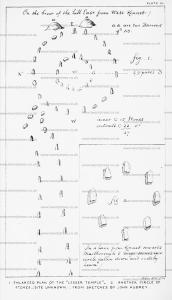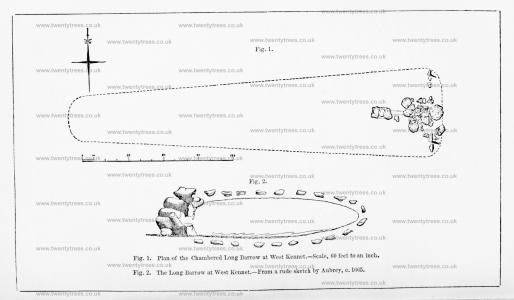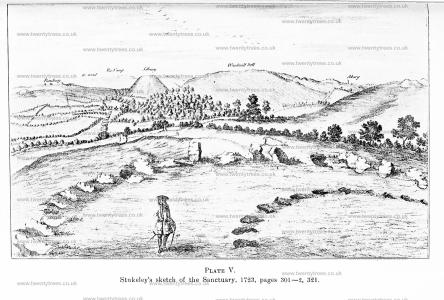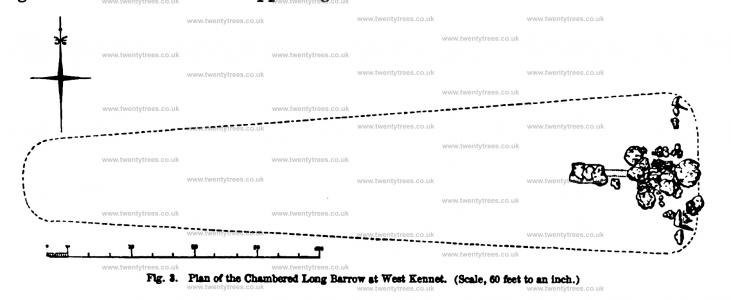Biography of Farmer Green
Colt Hoare 1812. This Overton hill, from time immemorial, the country people, have a high notion of. It was (alas! it was ) a very few years ago, crowned with a most beautiful temple of the Druids. They still call it the Sanctuary [Map]. I doubt not but it was an asylum in Druid times, and the veneration for it has been handed down through all succession of times and people. It had suffered a good deal when I took the prospect of it with great fidefity, anno 1723. Then farmer Green took most or the stones away to his building at Bekhampton, and in the year 1724 farmer Griffin ploughed half of it up; but the vacancy of every stone was most obvious, the hollows still left fresh. In the winter of the same year, the rest were carried off, and the ground ploughed over.
Avebury by William Stukeley. There are likewise about Abury some pyriform barrows, longish, but broad at one end: some composed of earth, thrown into a tumulus. Of this sort a very long one in the valley from Bekamton to Runway-hill. Another among the furze bushes south of Silbury, set with stones, which farmer Green carryed away. Others made of stones set upright in that form. Of the latter, a very large one in Monkton-fields, about 20 stones left on one side. 46 [Map] 'Tis directly north of Abury town. Another such south of Silbury-hill. Another pyriform, made only of earth, under Runway-hill. Another on the hill south-west from Bekamton, cut through with some later division dike.
Avebury by William Stukeley. The temple that stood here was intended for the head of the snake in the huge picture; and at a distance, when seen in perspective, it very aptly does it. It consisted of two concentric ovals, not much different from circles, their longest diameter being east and west. By the best intelligence I could obtain from the ruins of it, the outer circle was 80 and 90 cubits in diameter, the medium being 85, 146 feet. It consisted of 40 stones, whereof 18 remained, left by farmer Green; but 3 standing. The inner circle was 26 and 30 cubits diameter, equal to the interval between circle and circle.
Avebury by William Stukeley. Of the exterior circle of this northern temple but three stones are now left standing, six more lying on the ground, one whereof in the street by the inn-gate. People yet alive remember several standing in the middle of the street; they were burnt for building, anno 1711. That at the corner of the lane, going to the north gate of the town, not many years since lying on the ground, was used as a stall to lay fish on, when they had a kind of market here. The ruin of the rest is noted in the ground-plot, and so of the others. But they told us, that about a dozen years ago both circles were standing, and almost entire. Those in the closes behind the inn, were taken up a year ago; (this was when I first went thither, about 1718,) farmer Green chiefly demolished them to build his house and walls at Bekamton. Of the southern temple several stones were destroyed by farmer John Fowler, twelve years ago; he owned to us that he burnt five of them; but fourteen are still left, whereof about half standing. Some lie along in the pastures, two let into the ground under a barn, others under the houses. One lies above ground under the corner of a house, over-against the inn. One buried under the earth in a little garden. The cavities left by some more are visible, in the places whereof ash-trees are set. All those in the pastures were standing within memory.
Avebury by William Stukeley. About 1694, Walter Stretch, father of one of the present inhabitants, found out the way of demolishing these stones by fire. He exercised this at first on one of the stones standing in the street before the inn, belonging to the outer circle of the southern temple. That one stone, containing 20 loads, built the dining-room end of the inn. Since then Tom Robinson, another Herostratus of the place, made cruel havock among them. He owned to us, that two of them cost eight pounds in the execution. Farmer Green ruined many of the southern temple to build his houses and walls at Bekamton. Since then many others have occasionally practised the sacrilegious method, and most of the houses, walls, and outhouses in the town are raised from these materials. Sir Robert Holford resented this destruction of them; and Reuben Horsall, parish-clerk, had a due veneration for these sacred remains, and assisted me in the best intelligence he was able to give. Concerning the purport of the disposition and manner of the temple hitherto described, I shall speak more largely in chap. X. toward the end, concluding this with an inscription of the Triopian farm consecrated by Herodes Atticus.
Ne cuiquam glebam, saxumve impune movere [Let no one move a clod or stone with impunity]
Ulli sit licitum. Parcarum namque severæ [Anyone is allowed. For the frugal and severe]
Pœnæ instant: siquis sacra scelus edat in æde. [Punishment is urgent: if the sacred crime eats in the food]
Finitimi agricolæ, & vicini attendite cuncti, [Neighbors, farmers, and neighbors were attentively gathered]
Hic fundus sacer est; immotaque jura deorum. [This ground is sacred; and the immovable law of the gods]
Avebury by William Stukeley. This Overton-hill, from time immemorial, the country-people have a high notion of. It was (alas, it was!) a very few years ago, crowned with a most beautiful temple of the Druids. They still call it the sanctuary [Map]. I doubt not but it was an asylum in Druid times; and the veneration for it has been handed down thro' all succession of times and people, as the name, and as several other particulars, that will occasionally be mentioned. It had suffered a good deal when I took that prospect of it, with great fidelity, anno 1723, which I give the reader in plate XXI. Then, about sixteen years ago, farmer Green aforementioned took most of the stones away to his buildings at Bekamton; and in the year 1724 farmer Griffin ploughed half of it up. But the vacancy of every stone was most obvious, the hollows still left fresh; and that part of the two circles which I have drawn in the plate, was exactly as I have represented it. In the winter of that year the rest were all carryed off, and the ground ploughed over.
Wiltshire Archaeological Magazine 1857 V4 Pages 307-363. I have been more particular in giving a full account of this avenue, as the question naturally arises, how far should Aubrey's silence respecting the Beckhampton avenue affect our faith in Stukeley's description of it?1 Aubrey and Dr. Musgrave, both mention the 'Devil's Coits' only, and we have no one to speak to the fact of there having been other stones in that neighbourhood but Twining, who mentions "other stones lying in the same field." It must, however, be observed that the course of the Beckhampton avenue from Abury is of a more private character than that of the Kennet avenue. It does not adjoin any public road until it approaches Beckhampton, and it passed for the most part over fields, which have been for a long time in cultivation. Scattered stones might therefore have been lying about on the line of it which would not attract the notice of a careless observer, while the great size of the stones called the 'Devil's Coits' would throw smaller ones into the shade. And except in the open fields leading to Beckhampton, it would have been difficult, one would think, to find any stones remaining; as, unlike the line of the other avenue, this one has a great many cottages and a bridge on its course, which would naturally be constructed out of so convenient a quarry. Many stones, too, besides those brought thither by Farmer Green, must have been used in building at Beckhampton. It is very likely that Stukeley's "original memoirs which he wrote on the spot very largely," and of which he adds "that it was necessary for him then to do it, in order to get a thorough intelligence of it," (See p. 16), may throw further light upon this matter and help to clear up the question, how far his Dracontian theory, as applied to Abury, had its origin in facts; or how far his fancy for that particular theory may have led him to supply from his own imagination the deficiencies in the evidence necessary for its support. It must, at present, be admitted that the evidence for this western avenue is of a much less decisive character than that for the eastern. Different minds will regard it in different ways. Some will think that it extended no further than the "Cove" or "Long Stones;" some that it ended, like that leading to Kennet, in a circle, or double circle of stones; whilst others, among whom the favorers of Ophite theories of various kinds will be found, will with Stukeley, (and perhaps truly,) see in its "disjecta membra" [dismembered limbs] the tail of the Great Serpent, forming an avenue of equal length with that which leads to Kennet.
Note 1. It is possible that Mr. E. Philips's information (see p. 317) may have referred to some of the buildings in the neighbourhood of 'South Street', on the line of this avenue.
Wiltshire Archaeological Magazine 1857 V4 Pages 307-363. The Avenues and Sanctuary
We now proceed to the avenues, each of which was composed of 200 stones, and was of a sinuous course, and about a mile and a half in length. The head of the serpent, (which reptile the whole work was supposed by Stukeley to have been designed to represent,) rested on Overton or Kennet Hill, and the tail extended from Abury in the direction of Beckhampton. The head was called the "Sanctuary [Map]," and was composed of two concentric ovals, the outer containing 40, the inner 18 stones.1 The diameter of the outer oval, according to Stukeley, was 138 feet 4 inches by 155 feet 6 inches. That of the inner one was 44 feet 11 inches by 51 feet 103 inches. Of these circles, as he found them in 1723, Stukeley gives an engraving.2 They stood in what is still called Mill Field, and their sites are shown in Nos. 20, 21, and 29 of Stukeley's illustrations. Farmer Green took away the stones and Farmer Griffin ploughed up the ground, in 1724. 'The loss of this work," says Stukeley [See Stukeley],3 "I did not lament alone; but all the neighbours (except the person that gain'd the little dirty profit) were heartily griev'd for it. It had a beauty that touch'd them far beyond those much greater circles in Abury town. The stones here were not large, set pretty close together, the proportions of them with the intervals, and the proportions between the two circles, all being taken at one view under the eye, charmed them. The great stones of the great circles at Abury were not by them discern'd to stand in circles, nor could they easily be persuaded of it. But these of the sanctuary they still talk of with pleasure and regret."
Note 1. "It can hardly now be thought that the number was really 19, as some have supposed, e.g. the Rev. E. Duke, 'Druidical Temples of Wiltshire,' p. 64, 178. Several megalithic circles in Cornwall are of 19 stones, also the inner oval at Stonehenge, as is thought; and each side of the avenue at Classerness; in all of which the number 19 is with some reason believed to refer to the Metonie Cycle." —[Dr. Thurnam. ]
Note 2. For Aubrey's account of these circles on Overton Hill, see above p. 317, and for his plan of them, see plate 3, fig. 1. He makes the diameter of the outer circle 45 paces, of the inner 16; the outer circle to consist of 22 stones, the inner of 15, There are no traces on his plan of the cireular trench around it, which he mentions in his description. The mode in which the avenue narrowed and bent at its junction with the outer circle, as shown by him, is very curious, and favours the notion of a dracontine form.
Note 3. It is difficult to discover the extent of Stukeley's acquaintance with the 'Monumenta Britannica.' With reference to the 'Sanctuary,' he writes as if he had not seen more than the short account published in Gibson's edition of Camden's 'Britannia;' while it is clear from pages 33 and 45 of his "Abury," that he must have known more of the MS. than is there printed.

Wiltshire Archaeological Magazine 1866 V10 Pages 130-135. This long barrow has suffered much at the hands of the cultivators of the soil. Whilst the "Farmer Green" of Stukeley's days seems to have removed nearly all the stones which bounded its base, two being all which remain standing; later tenants, even in the present century, have stripped it of its verdant turf, cut a waggon-road through its centre, and dug for flints and chalk rubble in its sides, by which its form and proportions have been much injured. In spite of all this, however, the great old mound with its grey, time-stained stones, among which bushes of the blackthorn maintain a stunted growth—commanding as it does a view of Silbury Hill, and of a great part of the sacred site of Avebury—has still a charm in its wild solitude, disturbed only by the tinkling of the sheep-bell, or perhaps the cry of the hounds. Shade, too, is not wanting; for on the north side of the barrow, occupying the places once filled by the encircling upright stones, are, what are rarely seen on these downs, several ash and elm trees of from fifty to seventy years' growth. At the foot of the hill, half a mile away to the east, lies one of those long combs or valleys where the thickly scattered masses of hard silicious grit or sarsen stone, still simulate a flock of grey wethers," and which, as Aubrey says, "one might fancy to have been the scene where the giants fought with huge stones against the gods." From this valley there can be little doubt were derived the natural slab-like blocks, of which our "giant's chamber " and its appendages were formed.

Wiltshire Archaeological Magazine 1913 V38 Pages 379-414. Stukeley's description of Long barrows round Abury is as follows:—
Abury, p. 45, "There are likewise about Abury some pyriform barrows longish, but broad at one end; some composed of earth thrown into a tumulus. Of this sort a very long one in the valley from Bekamton to Runway Hill." (This apparently is the one referred to by Thurnan as "Bishops Cannings." See Barrows no longer in existence under that parish.)
"Another set with stones among the furze bushes south of Silbury Hill, which Farmer Green carried away." (This refers to the stones of West Kennet Long Barrow, also called by Stukeley " South Long Barrow.")
p. 46. "Another such south of Silbury Hill." (Another reference to West Kennet?) "Another pyriform made only of earth under Runway Hill." (Another reference to "Bishops Cannings"?). "Another to the south-west from Bekamton cut thro with some later division dyke." (This cannot be identified.) "One very large at East Kennet" (East Kennet Long Barrow, see under Kennet.) " Another not far off points to the Snake's Head Temple, being at a right angle to the former." (This cannot be identified unless it be the twin barrow Avebury 30a referred to below.) "By Horslip Gap is another considerable long barrow of a large bulk, length, and height; it regards the Snake Head temple though here not in sight." (This cannot be identified.)
[Stukeley]. "By Bekamton Cove another, a vast body of earth." (This is the Longstone Barrow [Map]; see under Avebury.)
Stukeley then describes Milbarrow [Map] (see "Barrows now Destroyed," under Winterbourne Monkton; and "South Long Barrow [Map]" (West Kennet), which latter he says is 180 cubits in length.
Again on p. 47 he describes a Long Barrow at Old Chapel, on Temple Down, now destroyed (see under Preshute), and on p. 49 the Shelving Stones, and the Devil's Den.
Wiltshire Archaeological Magazine 1930 V45 Pages 300-335. PLATE V.
Stukeley’s sketch of the Sanctuary entitled ‘Prospect of the Temple on Overton Hill, 8 July, 1723. The Hakpen, or head of the Snake in ruins," Stukeley says "It had suffer’d a good deal when I took that prospect of it, with great fidelity, anno 1723, which I give the reader in plate xxi. Then, about sixteen years ago, farmer Green aforemention’d took most of the stones away to his buildings at Bekampton; and in the year 1724 farmer Griffin plough’d half of it up. But the vacancy of every stone was most obvious, the hollows still left fresh, and that part of the two circles which I have drawn in the plate was exactly as I have represented it. In the winter of that year the rest were all carry’d off, and the ground ploughed over." (Abury, 31).
The inner ring is represented by holes only, all the stones evidently hav- ing been removed. ‘The stone lying outside the rings, to the right, must be the one that stood in the hole N1 or N2 on plan (Plate I. and page 306).

Archaeologia Volume 38 1883 Section XXVII. South Long Barrow has suffered much at the hands of the cultivators of the soil. Whilst the "Farmer Green" of Stukeley's days seems to have removed nearly all the stones which bounded its base, two being all which remain standing, later tenants, even in the present century, have stripped it of its verdant turf, cut a waggon-road through its centre, and dug for flints and chalk rubble in its sides, by which its form and proportions have been much injured. In spite of all this, however, the great old mound, with its grey, time-stained stones, among which bushes of the blackthorn maintain a stunted growth, commanding as it does a view of a great part of the sacred site of Avebury, has still a charm in its wild solitude, disturbed only by the tinkling of the sheep-bell, or perhaps the cry of the hounds. Shade, too, is not wanting; for on the north side of the barrow, occupying the places once filled by the encircling upright stones, are, what are rarely seen on these downs, several ash and elm trees, of from fifty to seventy years ' growth. At the foot of the hill, half a mile away to the east, lies one of those long combs or valleys, where the thickly scattered masses of hard silicious grit, or sarsen stone, still simulate a flock of "grey wethers," which, as Aubrey says, "one might fancy to have been the scene where the giants fought with huge stones against the gods." From this valley there can be little doubt were derived the natural slab-like blocks, of which our "giant's chamber" and its appendages were formed.

Archaeologia Volume 38 1883 Section XXVII. Dr. Stukeley's description was written about 1725, in which year, probably, his sketch of the barrow, which he absurdly designates that of an Arch-Druid, was made.b Stukeley gives it the name of South Long Barrow, from its situation in respect to Silbury Hill, and the circles of Avebury. He says: "It stands east and west, pointing to the dragon's head on Overton-hill. A very operose congeries of huge stones upon the east end, and upon part of its back or ridge, piled one upon another, with no little labour - doubtless in order to form a sufficient chamber for the remains of the person there buried — not easily to be disturbed. The whole tumulus is an excessively large mound of earth, 180 cubits long ( i. e. 320 feet ), ridged up like a house. And we must needs conclude the people that made these durable mausolea had a very strong hope of the resurrection of their bodies, as well as souls, who thus provided against their being disturbed." Stukeley's large view, taken from the south, shows no peribolus of stones on that side; but in two distant views six or eight standing stones appear at the east end. The rest of these stones, figured by Aubrey sixty years previously, had probably been removed by that great depredator of the Avebury circles and avenues, "Farmer Green," who, about the year 1710, as we learn from Stukeley, removed similar stones from a neighbouring barrow, "to make mere-stones withal" —the boundaries probably of his own sheep-walks. Among the unpublished papers of Stukeley's, referred to in a previous note, is a further notice of this tumulus, as to which he says, "Dr. Took, as they call him,a1 has miserably defaced South Long Barrow by digging half the length of it. It was most neatly smoothed up to a sharp ridge, to throw off the rain, and some of the stones are very large."
Note b. Abury, p. 46. Tab. xxxi. compare Tab. xxx. for the date; and Tab. xxi. and xxi. or distant views of the barrow. In a collection of unpublished sketches and papers of Stukeley's, which fell into the hands of Gough and are now in the Bodleian, are two or three plans and drawings of South Long Barrow, showing the position of the stones on the surface at the east end, much as they still remain.
Note a1. Meaning no doubt the Doctor Toope, whose letter to Aubrey is preserved in his "Monumenta Britannica."